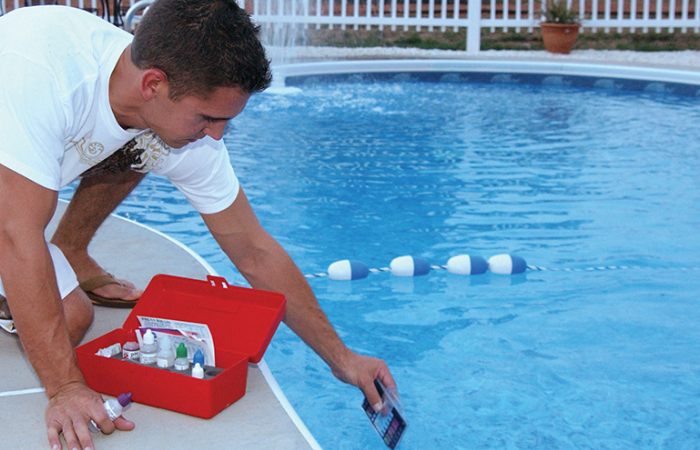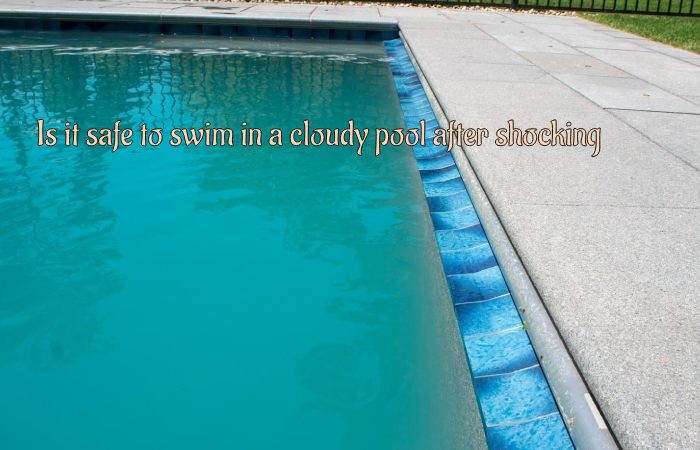Table of Contents
Introduction
Accidentally Swam in Shocked Pool, there’s nothing more enticing than a nice swimming pool. However, a pool that hasn’t been used for a while needs to be primed or “flushed” before you can dive in and splash around or make laps.
Rinsing is essential to remove any pathogens in the water and make the pool safe to swim in, but it does involve the use of some heavy chemicals, including chlorine.
Getting in too soon after a pool has been electrically shocked can cause skin, eye and even lung problems.
It’s hard to wait to take a dip, but it’s not worth playing with your health. Here’s what you need to know before taking the plunge.
Can You Swim While Shocking Pool?

If you’ve owned or operated a swimming pool, you’ve probably heard the term.
Shocking is “the process of adding chemicals to the pool to make the water composition ideal so that chlorinated or non-chlorinated alternatives work better,” Jamie Alan, PhD, an associate professor of pharmacology and toxicology at the Michigan. .
The goal of electroplating the pool is to raise the level of “free chlorine” in the pool to the point where things like algae and bacteria are destroyed.
There are a variety of chemicals that can be used for a pool shock, including calcium hypochlorite and chlorinated iso-cyanurates such as tri-chloroisocyanuric acid or potassium dichloroisocyanurate.1
How Long Does Pool Shock Last?

In general, waiting up to 24 hours to enter a pool after getting an electric shock is recommended, depending on the size of the pool, Alan said.
If you’re overseeing pool maintenance, Alan said it’s also a good idea to test the pH and chlorine of the water to make sure they’re in the right range before you or anyone else enters the pool.
A good chlorine level is between 1.0 and 4.0 parts per million, and the pH should be between 7.2 and 7.8, according to the Centers for Disease Control and Prevention.2
How Long To Wait Between Shocking Pool?
There are some potential problems. “The chlorine will react with the water to produce an acid,” Alan said.
“The effects will be different depending on whether the chlorine is inhaled or comes into contact with the skin or eyes.”
At the very least, “you would definitely have dry skin,” Gary Goldenberg, MD, clinical assistant professor of dermatology at the Icahn School of Medicine at Mount Sinai in New York City, told Health.
And, if you have a skin condition like eczema or psoriasis, Dr. Goldenberg said this could cause a breakout.
You can even deal with symptoms like burning, redness, pain and blisters, Alan added.
And, if you accidentally drink some of the pool water, you could end up feeling nauseous and even throw up.
Fortunately, Alan said, “the effects are often reversible.” If you jump into a pool too soon after being shocked and start noticing symptoms, Alan said it’s important to get out as soon as possible and get some fresh air (that is, away from the pool).
“Remove all exposed clothing and wash all affected areas thoroughly with soap and water,” Alan said.
If you wear contact lenses, he also recommended removing them and rinsing your eyes “thoroughly” with saline.
If your skin feels uncomfortable after cleansing, Dr. Goldenberg recommends using a moisturizer or topical steroid cream if symptoms don’t improve.

According to National Capitol Poison Control, if skin or eye irritation persists or worsens, or if you experience shortness of breath, chest tightness, or wheezing, you should seek immediate medical attention.
On a hot day, there is nothing more tempting than a good swimming pool.
Should I Backwash After Shocking Pool?
If you have owned or operated a swimming pool, you have probably heard the term.
Striking is “the process of adding chemicals to the pool to make the composition of the water ideal for chlorinated or non-chlorinated alternatives to work better,” Jamie Alan, PhD, associate professor of pharmacology and toxicology at Michigan.
The goal of pool electroplating is to raise the level of “free chlorine” in the pool to the point where things like algae and bacteria are destroyed.
There are a variety of chemicals that can be used for a pool shock, including calcium hypochlorite and chlorinated.
Is It Safe To Swim In A Cloudy Pool After Shocking

It is generally recommended to wait up to 24 hours to enter a pool after receiving an electrical shock, depending on the size of the pool, Alan said.
If he’s overseeing pool maintenance, Alan said it’s also a good idea to test the pH and chlorine of the water to make sure they’re in the right range before you or anyone else enters the pool.
A good chlorine level is between 1.0 and 4.0 parts per million, and the pH should be between 7.2 and 7.8, according to the Centers for Disease Control and Prevention.
However, a pool that hasn’t been used for a while needs to be filled or “flushed” before you can jump in and splash or do laps.
Rinsing is essential to removing any pathogens in the water and making the pool safe to swim in, but it does involve the use of some heavy chemicals, including chlorine.
Going in too soon after a pool has been electrically shocked can cause skin, eye, and even lung problems.
It’s hard to wait to take a dip, but it’s not worth messing with health. Here’s what you need to know before you take the plunge.
There are some potential problems. “The chlorine will react with the water to produce an acid,” Alan said. “The effects will be different depending on whether the chlorine is inhaled or comes into contact with the skin or eyes.”
Conclusion
At the very least, “I would definitely have dry skin,” Gary Goldenberg, MD, a clinical assistant professor of dermatology at the Icahn School of Medicine at Mount Sinai in New York City, told Health.
And, if you have a skin condition like eczema or psoriasis, Dr. Goldenberg said this could cause a breakout.
You can even deal with symptoms like burning, redness, pain, and blistering, Alan added.
The water can also damage the eyes and lungs. “Effects to the eyes would include pain, redness, blurred vision and watery eyes,” Alan said.
“The effects of inhalation are usually the most severe and include shortness of breath, chest tightness, wheezing, and fluid in the lungs.”


